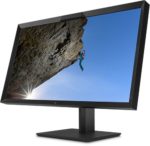I did make it to NAB this year, but haven’t had a chance to post since I got back a week ago. HDR and 360 video are where the main innovations could be found this year. Everyone is announcing support for HDR workflows and files, as television moves towards utilizing the capabilities offered by Rec.2020. There are still lots of confusing aspects to the various options and color spaces to get there, but everyone is looking towards an HDR future. The was an entire VR pavilion, mostly focused on 360 video production and workflows. This is as opposed to true Virtual Reality, which requires synthetic rendering to provide the viewers perspective. 360 video allows viewers to explore the world from a fixed point, where the camera originally recorded from.
 On the hardware from, the main items attracting attention were new displays, and the first one on my list isn’t even HDR. HP announced the new Dreamcolor Z31x, which has a full cinema 4096×2160 resolution panel and a fully integrated colorimeter that swivels down from the bezel to calibrate the panel. It is expected to be dramatically more expensive than the previous Dreamcolors, but cheaper than competitive options. I has a double pixel mode for monitoring 2K accurately, as well as integrated markers, matting, KVM, and many other features. I can imagine this being a good finishing display for a smaller post operation.
On the hardware from, the main items attracting attention were new displays, and the first one on my list isn’t even HDR. HP announced the new Dreamcolor Z31x, which has a full cinema 4096×2160 resolution panel and a fully integrated colorimeter that swivels down from the bezel to calibrate the panel. It is expected to be dramatically more expensive than the previous Dreamcolors, but cheaper than competitive options. I has a double pixel mode for monitoring 2K accurately, as well as integrated markers, matting, KVM, and many other features. I can imagine this being a good finishing display for a smaller post operation.
 Another non-HDR display that got my attention was Dell’s new 8K monitor. The PU3218K has 7680×4320 in its 32″ panel, for a total of over 33Megapixels. I had heard about this monitor coming and wanted to experience it for myself, since reading about it will never be the same as viewing it. To be honest, even as a guy who likes high resolution displays, it was not really as impressive as I was expecting. The visible difference at that size, even viewed up close, is nearly imperceptible compared to 4K. You have need to have a 55″ or 65″ display for the added resolution to actually be functional.
Another non-HDR display that got my attention was Dell’s new 8K monitor. The PU3218K has 7680×4320 in its 32″ panel, for a total of over 33Megapixels. I had heard about this monitor coming and wanted to experience it for myself, since reading about it will never be the same as viewing it. To be honest, even as a guy who likes high resolution displays, it was not really as impressive as I was expecting. The visible difference at that size, even viewed up close, is nearly imperceptible compared to 4K. You have need to have a 55″ or 65″ display for the added resolution to actually be functional.
Speaking of larger TVs, Sony was showing off their new A1E line of OLED displays with a very unique feature. Besides the HDR picture it has t ooffer, the surface of the screen itself is set up to be a speaker, and actually creates a very impressive acoustic experience. As a fan of discrete surround sound, I would only want to use it for the center channel audio, if I could afford one, but it did make for a compelling demonstration of new technology.
On the software front, Adobe is to be commended for releasing their NAB updates to Creative Cloud before the show instead of months afterwards. There are a variety of new features, especially for 360 video editing and motion graphics, that you can read about all sorts of other places. The one new thing that really stood out to me was the new Camera Shake DeBlur effect, that is pretty self explanatory, but still very exciting none the less. Stabilizing footage removes the motion, but frequently the motion has caused a variable blur that is still visible in the stabilized shot. This new option in After Effects analyzes the surrounding frames, searching for sharper image data, and replaces that data in the blurred frames, assuming that there are some sharp frames nearby. I have a number of shots in previous projects that would have benefited greatly from this, and I am looking forward to giving it a try on some of them.
Anyhow, it was good to have time to see actually browse around and see things at the show, since this is the first time in ten years that I wasn’t staffing a booth as a demo artist. It gave me lots of time to explore what new stuff is out there, and have some good conversations with the people who are developing it. I am looking forward to a number of things that will be coming out later this year.

